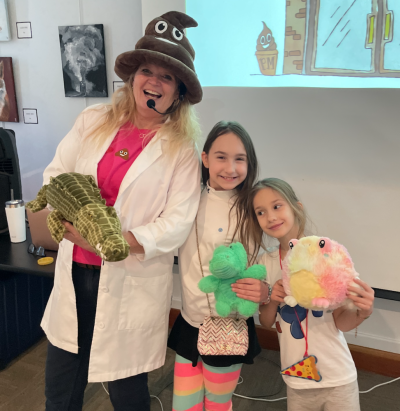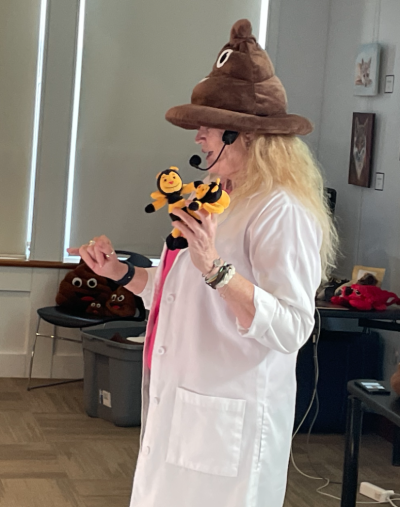Here’s the poop: Animals make waste in funny ways
LAKEVILLE — No butts about it: Suzie Maguire loves poop.
“I don’t love it because it’s brown and sticky,’’ she told a crowd of children and their families at an appearance at the Lakeville Public Library Wednesday, Feb. 19. “I love it because it’s one of the most interesting things I’ve learned about.’’
Through her program, The Poop Museum, she shared that enthusiasm and introduced youngsters to a variety of animals and their pooping preferences, much to the laughter and excited shrieks of the group.
Snails, for example, aren’t particularly fussy eaters. They will eat yellow flowers, colored cardboard and paper, which they use for the calcium their shells need, and even bird poop.
Because what comes in must go out, snail poop reflects the color of the items they have eaten, which can result in yellow, blue and sometimes multi-color droppings, or, as Maguire called it, “rainbow poop.’’
Queen bees, she said, live up to their name. They rule the roost _ or the hive, in their case _ and do not allow any other bees to poop inside her home.
This is not a problem in the warmer weather, when the bees flit around outside much of the time. But in the winter, when they are hive-bound, the bees are forced to hold in their poop, leading to a big sense of relief when the winter breaks and they are able to fly _ and make one giant poop _ outside.
Pandas, she explained, have to consume a lot of bamboo to receive enough nutrition. They eat some 16 hours a day.
That means they earn the title “Poop a lot panda,’’ because they have been known to poop 50 times a day, Maguire informed the children.
She also told them that contrary to the saying “Everybody Poops,’’ one animal doesn’t: The butterfly. They only drink liquids, and their bodies take in most of what they consume.
But, she told the youngsters conspiratorily, they do fart.
Then there is the animal who is responsible for the beautiful beaches that tourists love: The parrotfish.
This fish eats algae found on coral, which then they pass through their digestive tract and expel as fine-grain white sand.
Scientists have estimated that as much as 70 percent of the sand on the white sandy beaches in the Caribbean and Hawaii consist of, believe it or not, parrotfish poop.
A large parrotfish can produce hundreds of pounds of white sand each year, scientists have said.
It takes a lot of poop, it seems, to make a luxury vacation _ and a lively Lakeville afternoon.















